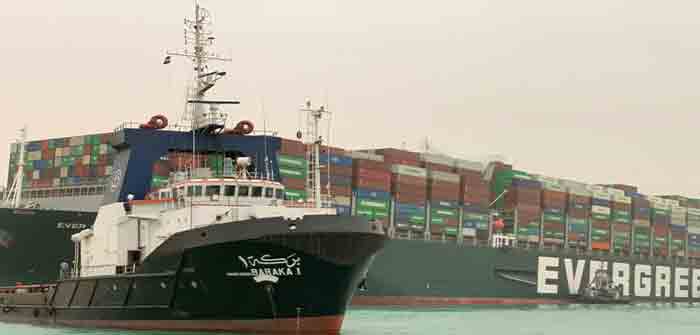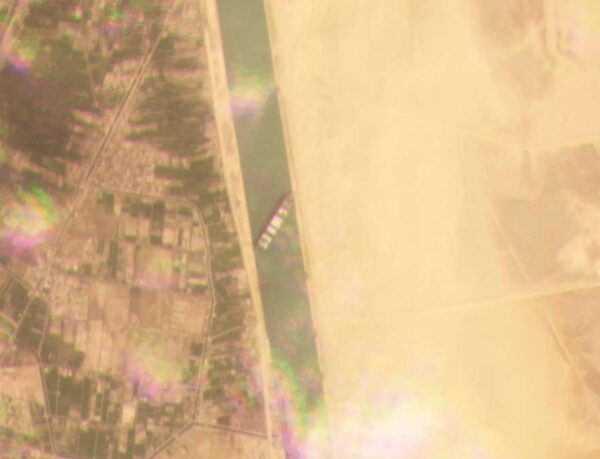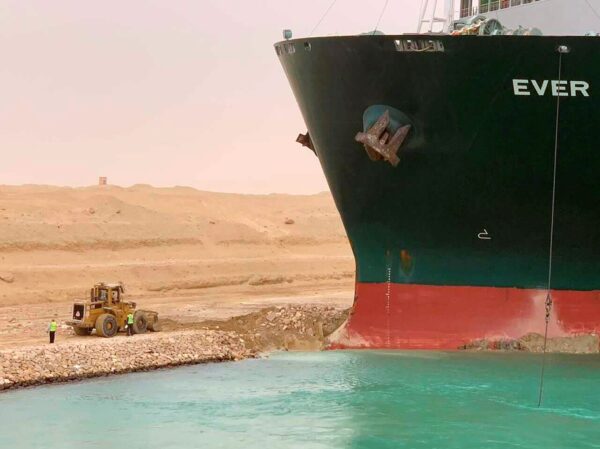
by Isabel Van Brugen at The Epoch Times
The skyscraper-sized cargo ship blocking Egypt’s Suez Canal like a “beached whale” may remain stuck for weeks as salvage teams work to free the vessel.
Officials blocked ships from entering the waterway after the MV Ever Given, a Panama-flagged ship that carries cargo between Asia and Europe, ran aground on Tuesday in the narrow, man-made canal dividing continental Africa from the Sinai Peninsula, amid a dust storm and high winds.
Built in 2018, the ship is nearly as long as the Empire State Building is high, with a length of nearly 400 meters (a quarter mile) and a width of 59 meters (193 feet). It is among the largest cargo ships in the world.
 This satellite image shows the cargo ship MV Ever Given stuck in the Suez Canal near Suez, Egypt, on March 23, 2021. (Planet Labs Inc. via AP)
This satellite image shows the cargo ship MV Ever Given stuck in the Suez Canal near Suez, Egypt, on March 23, 2021. (Planet Labs Inc. via AP)The 120-mile-long (193-kilometer-long) Suez Canal—linking Asia and Europe without having to circumnavigate Africa, which can take weeks—is one of the busiest shipping channels for oil, grain, and other trade in the world, and the stuck vessel threatens to disrupt the system that is already strained by the CCP (Chinese Communist Party) virus pandemic.
“We can’t exclude it might take weeks, depending on the situation,” Peter Berdowski, CEO of Dutch company Boskalis, which is assisting in the operation to free the vessel, told local news station Nieuwsuur.
Berdowski suggested that “it is not really possible to pull it loose” and that the Ever Given may need to be unloaded.
“It’s like an enormous beached whale. It’s an enormous weight on the sand. We might have to work with a combination of reducing the weight by removing containers, oil, and water from the ship, tugboats and dredging of sand,” he said.
The disruption is wreaking havoc on the shipping industry, with shippers attempting to reroute vessels carrying oil, commodities, and consumer goods to avoid being backed up at either end of the Suez Canal.
According to tracking data, some 206 large container ships including tankers are stuck in a massive shipping jam in the narrow waterway through which around 10 percent of world trade flows.
 A cargo ship, named the Ever Given, sits with its bow stuck into the wall in Egypt’s Suez Canal, on March 24, 2021. (Suez Canal Authority via AP)
A cargo ship, named the Ever Given, sits with its bow stuck into the wall in Egypt’s Suez Canal, on March 24, 2021. (Suez Canal Authority via AP)The iconic shipping journal Lloyd’s List estimates that goods worth $9.6 billion pass through the canal every day. Lloyd’s says about $5.1 billion of that traffic is westbound and $4.5 billion is eastbound.
Salvatore R. Mercogliano, a former merchant mariner and associate professor of history at North Carolina’s Campbell University, warned that the disruption could have a major knock-on effect for global shipping moving between the Mediterranean Sea and the Red Sea.
“Every day, 50 vessels on average go through that canal, so the closing of the canal means no vessels are transiting north and south,” Mercogliano told The Associated Press. “Every day the canal is closed … container ships and tankers are not delivering food, fuel, and manufactured goods to Europe and goods are not being exported from Europe to the Far East.”
Concerns have also been raised by security experts that vessels idling in the Red Sea, on one side of the Suez Canal, could be targeted amid heightened tensions between the United States and Iran.
Salvage teams from Japan and the Netherlands…
Continue Reading